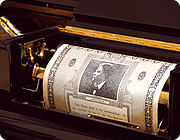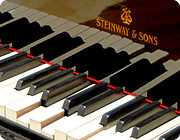Introducing some of Akio Morita's particular favorites from among the 'sound toys' that he collected all over the world.
![]()

In 1964, more than forty years ago now, Akio and I, together with our three children, had gone to live in Manhattan for a year to learn about American life. At the time, an American friend of ours who lived in California had a player piano like this one. Akio was interested in unusual sound-producing machines, and immediately decided that he wanted one. He asked our friend to look for one for him. This is the one he eventually acquired.
It was in an ordinary house about an hour and a half along the highway out of New York, among seven or eight similar antique pianos. The owner of the house was showing us around. We stopped in front of a grand piano that stood imposingly at the very back. "This is the piano you're looking for. Would you like to hear what it sounds like?" With a practiced hand, the owner inserted an aged paper roll into a mechanism built into the piano and moved a lever. The paper roll, which was pierced all over with little holes much like a rolled up punch-card, started to move.

The piano began to play. It was Liszt's Hungarian Rhapsody.
"The person playing is Paderewski, who was once prime minister of Poland, and was also a great pianist."
"This is George Gershwin's Rhapsody in Blue, played by the composer himself."
There was nobody seated at the piano, but the keys were moving by themselves. The soft and sustaining pedals were also moving, as though pressed down by invisible feet, and intonation was added to the beautiful harmony.
I recalled a scene in a western movie I saw as a child in which an upright piano suddenly started playing. The music in that scene had an entirely mechanical tone, but the sound of this piano had real feeling in it. It was a year since Akio had first talked to me about these automatic player pianos, but I had never imagined anything as wonderful as this.
"What do you think? Surprised, I'll bet." I was standing there dumbfounded. Akio took hold of my arm and began to tell me about the piano as though he already owned it. It was a Steinway semi-concert piano made in 1921, fitted with a Duo-Art playing mechanism. Only three of them had ever been made, and one had been destroyed in a fire. This was one of the two that still survived. He already seemed to be thinking about taking this large piece of freight back to Japan.
Akio's view was that since many Americans took Japanese antiques home with them after World War II, in which Japan fought America, we could at least take an American antique back to Japan. I, on the other hand, was wondering which room he intended to put this great big grand piano in when he got it back to our house in Tokyo.

Some time later, the world-famous pianist Alexis Weissenberg visited our home. I still remember that after listening to a piece performed by Horowitz he said "That's him playing, all right. I wish I could let him hear this performance by his younger self now."
The conductor Herbert von Karajan came to our house after a concert to refresh himself in the pool. After dinner, dressed in his customary black sports-shirt, he gazed at the piano, eyes shining. "Wonderful!"
This great big nuisance of a house-mate of ours is still here eight years after Akio's death. I have it tuned every year. People who remember us and are kind enough to visit still, as well as young people who never knew Akio, get a lot of pleasure out of the "sound-toys" that he collected.
Yoshiko Morita, May 14, 2007





























 The Player Piano
The Player Piano

